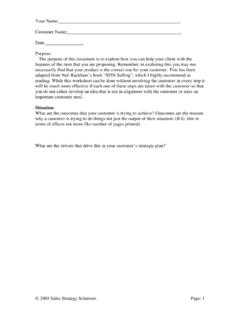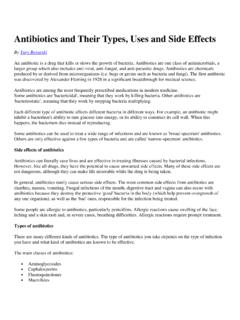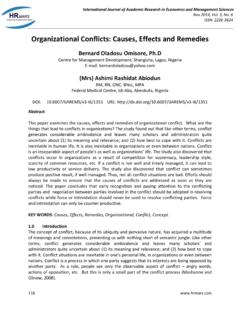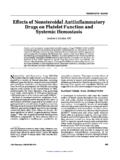Transcription of PFMEA Process Failure Mode and Effects Analysis
1 PFMEA . Process Failure Mode and Effects Analysis James Davis, General Dynamics Purpose The purpose of this presentation is to share the benefits of a detailed Process Flow Diagram, conducted during a Process Failure Mode and Effects Analysis , that will ensure product quality in the manufacturing/assembly Process . James Davis, GDLS Slide Number: 2. Introduction James Davis, GDLS Slide Number: 3. Definition of FMEA. A FMEA is an analytical tool that uses a disciplined technique to identify and help eliminate product and Process potential Failure modes. o By ID of potential failures o Assessing the risks caused by Failure modes and Identify corrective actions o Prioritizing corrective actions o Carry out corrective actions James Davis, GDLS Slide Number: 4. Most COMMON Types of FMEA's Design (Potential) Failure Modes and Effects Analysis -DFMEA.
2 Focus is on potential design- related failures and their causes. Process (Potential) Failures Modes and Effects Analysis - PFMEA . Focuses is on potential Process failures and their causes. James Davis, GDLS Slide Number: 5. Value of FMEA's z Aids in improving designs for products and Process Increased safety Enhances Customer Satisfaction o Better Quality o Higher Reliability z Contributes to cost savings Decreases warranty costs Decreases waste, non-value added operations James Davis, GDLS Slide Number: 6. PFMEA 's z Focus is on potential Process related failures and their causes. Main drive is to understand the Process through the identification of as many potential failures as possible. o Incorrect material used z PFMEA typically assumes that the design is sound. z Development of Recommended Actions is targeted at eliminating the Root Cause of the potential failures.
3 James Davis, GDLS Slide Number: 7. PFMEA . Three Parts: zProcess Flow Diagram (PFD). zProcess Failure Mode and Effects Analysis ( PFMEA ). zProcess Control Plan (PCP). James Davis, GDLS Slide Number: 8. Information Flow Customer Requirements: SOR, Vehicle Tech Specs, System Technical Specs Product Definition: Key Product Characteristics, DFMEA. Process Definition: Process Flow Diagram (PFD), Product and Process Characteristics Failure Mode Analysis : PFMEA . Control Strategy: Control Plan, Error proofing Manufacturing: Work Instructions & Process Monitoring James Davis, GDLS Slide Number: 9. DFMEA/ PFMEA Information Interrelationships Boundary (Block) Process Flow Diagram, P- Diagram, Diagram Etc. DFMEA PFMEA . Design FMEA Process FMEA. Process Control Design Verification Plan Plan & Report (DVP&R).
4 James Davis, GDLS Slide Number: 10. Process Flow Diagrams z The Process Flow Diagram provides a logical (visual). depiction of the Process that is being analyzed. James Davis, GDLS Slide Number: 11. Process Function / Requirement z The SAE/AIAG PFMEA guidelines describe two methods of defining Process functions. Either or both may be used. z Process Functions may be described in terms of: The product features/characteristics that are created or The Process actions that are performed z Process functions should be identified in detail as necessary to provide information for the PFMEA to develop effective Process Controls 12. James Davis, GDLS Slide Number: 12. Process Function / Requirement z Consider a simple operation to drill a hole in a metal part z The product characteristics & requirements are: Hole size: mm +/- Y.
5 X. Hole Location: X = mm +/- Y = mm +/- Perpendicular to surface, no burrs, etc. z Theprocess operation must create these product characteristics and meet the requirements 13. James Davis, GDLS Slide Number: 13. Process Function / Requirement z To drill the correct hole size in the specified location, the Process must: Position and hold the part Align the part fixturing with the drill position Assure the correct drill bit size is used Set and control drill speed Anticipate tool wear and schedule preventive maintenance z Ifthe Function/Requirement is defined in the PFMEA as Drill Hole could any of these be missed? James Davis, GDLS Slide Number: 14. Process Flow Diagram (PFD). z Process Flow Diagram is the foundation The Process must be defined step by step, including interfaces The PFD provides the structure to document what product characteristics and requirements (OUTPUTS) are affected by a given operation and how these characteristics and sources of variation are controlled (INPUTS).
6 PFD is a graphical representation of every possible path a part can take through the anticipated manufacturing Process A well defined PFD establishes the foundation for the PFMEA . z Helps in developing equipment specifications. How will the Process control non-conforming material? How and when will inspections be performed, what is required? How and when will parts be re-introduced into the Process ? James Davis, GDLS Slide Number: 15. Process Flow Diagram (PFD). z Hidden Factories: Interfacing Processes Quality Audits Product/tooling Changeovers Rework Processes Part Alternative Processes Teardown Scrap Gauging Stations Part Buffers Reject Handling Part Movement Interface Process issues affect quality performance o Rework and scrap parts bypass Process controls o Mixed parts in the manufacturing Process at changeovers z Need for common systems Part of the overall Quality Strategy must include o Common content, common format, common approach Quality strategy must extend to suppliers o Considered an extension of the Total Quality processes James Davis, GDLS Slide Number: 16.
7 SAE J1739 March 2009. James Davis, GDLS Slide Number: 17. Micro Level PFD Example James Davis, GDLS Slide Number: 18. Process Characteristics James Davis, GDLS Slide Number: 19. PFD Feeds PFMEA . Identify the Function(s). z Function is a description of what the Process does to meet the requirements Related to Process specification and product characteristics Comes from the PFD operation description column z Functions can be described as: Do this operation . To this part or material . With this tooling or equipment . James Davis, GDLS Slide Number: 20. PFD Feeds PFMEA . James Davis, GDLS Slide Number: 21. Linkage to PFMEA . James Davis, GDLS Slide Number: 22. PFMEA Example James Davis, GDLS Slide Number: 23. Sources and Types of Manufacturing Variation Source of Variation Types of Variation Typical Process Controls Operator Skill, Training, instructions, visual aids, feedback Operator Ergonomic Factors layout, motion Analysis , human factors Component / Incoming raw material, purchased Supplier management, internal controls, error Material parts, previous operations proofing Equipment / Machine capability, adjustment, Equipment specifications, closed-loop Machine wear over time machine controls, preventive maintenance Temperature, humidity, dust, noise Climate control, air filtration, clean room, Environment sound insulation Industrial Engineering techniques, Methods & Systems Sequence, procedure, layout Lean Flow Analysis Set Up Process specification, first / last piece check.
8 (for stable Initial set up or adjustment automated controls processes). Wear over time, breakage, Predictive maintenance, detection error- Tool tool-to-tool differences proofing, tooling specifications Repair, replacement, reassembly, Instructions, error-proofing, machine Maintenance adjustment qualification, production trial run Position tolerance, adjustment, Predictive maintenance, prevention and Fixture / Pallet wear over time detection error-proofing James Davis, GDLS Slide Number: 24. Process Control Plan z PCP will be based on the previous activities in PFD and PFMEA . z Review the PFMEA information developed & supplied and use to identify: Specific controls that may be needed due to the information added Identify which controls are Product or Process o Note any Special Characteristics o Identify evaluation methods, frequency and Control Methods o Note Reaction Plans (particularly related to NC parts).
9 James Davis, GDLS Slide Number: 25. Process Control Plan Example Form 818-1 (Rev 12 Apr02). Prototype Pre-Launch Production CONTROL PLAN Control Plan No: Part Number/Latest Change Level Key Contact/Phone Date (Orig.) Date (Rev.). Customer Part Number Core Customer Engineering Approval/Date (If Req'd.). Team Part Name/Description Supplier/Plant Approval/Date Customer Quality Approval/Date (If Req'd.). Supplier/Plant Supplier Code Other Approval/Date (If Req'd.) Other Approval/Date (If Req'd.). Characteristics Methods Part/ Machine, Special Process Name / Sample Reaction Process Device, Jig, Char. Product / Process Evaluation Operation Description Plan Number Tools for Mfg. No. Product Process Class. Specification / Measurement Control Method Tolerance Technique Size Frequency Weld beads Tube welds meet Pull test 1 pc.
10 Per shift. Hydraulic pull test Quarantine 300 Initiate weld sequence Robotic Arm per design pull test with using test instruction TI21-01 material / controller. specification. Failure in parent fixture 20-1. since last TIG welders. Process monitoring material. form PMF-20-01 good pull Perform TIG weld of test. frame parts. Good welds, yes Weld appearance Operator 100% Each Visual inspection OWI Remove part no visible meets visual evaluation to piece. #20-01. and send to defects. standard. Visual Std repair. TB20-VS1. Weld voltage yes 24 Volts AC Machine 100% Each weld Closed-loop machine Scrap part &. +/- volts Control cycle. control. Re-start welder. Weld voltage yes 24 Volts AC Visual Once Shift start Set-up OWI #20-02 & Scrap +/- volts each or Form PMF-20-02 current part. change- Periodic Shut down.







